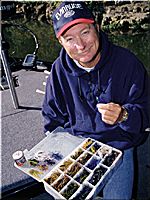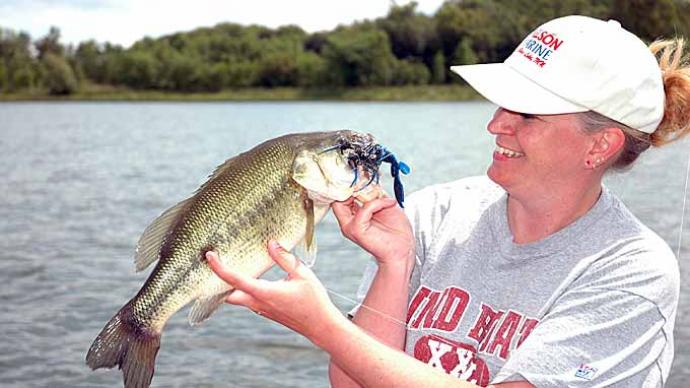
While weather and water conditions constantly change during the FLW Tour season, Denny Brauer's approach to catching bass rarely wavers. One thing is sure whether the skies are sunny or cloudy or the water is clear or muddy. Brauer will have a jig tied to at least one of his rods.
"It is probably the most versatile bait in fishing," says Brauer of his confidence lure. "One of the main reasons I use it is because I like to catch big fish. I don't know of any other bait that appeals more to quality fish than a jig."
Jigs allow Brauer to penetrate heavy cover more easily than other lures. "They also hook and hold a higher percentage of fish," he says.
The former Angler of the Year from Camdenton, Mo., relies on jigs in practically all weather and water conditions. "A lot of times, I'm going to use whatever bait I think is the most efficient," Brauer admits. "But I have so much confidence in jigs that I feel they are an appropriate bait in more circumstances than others. Many people won't fish jigs if they don't consider it perfect jig-fishing conditions."
An expert jig fisherman such as Brauer learns how to apply the lure under various conditions. Take, for instance, in the fall when there are a lot of baitfish up and a lot of bass suspended on targets. A traditional angler who hasn't spent much time with a jig will pitch one out and let it go to the bottom. Then, if he doesn't get a bite, he'll try something else like a crankbait or spinnerbait. Whereas a guy like Brauer, who often fishes jigs, realizes that if he starts swimming the lure rather than letting it go to the bottom, it will likely be in the same zone as the fish, and it is going to start generating some strikes.
Even though he sticks with the same lure throughout the year, Brauer varies the speed and motion of his retrieves depending on the season and the fish's mood. In colder water, he fishes and jigs at a slow, methodical pace, but as the water warms up in the spring, he speeds up his retrieves and imparts more erratic action to the lure.
"Everybody's willing to try a different color jig if they don't catch fish, but very seldom do they ever try a different speed or motion," Brauer says. "A lot of times, it's not the color; it's what you are doing with the bait, the size of the bait, and the speed of the fall. There are a lot of things that all come into play.
"Normally, I'm either working a jig on the bottom, figuring out the proper speed of fall - because a lot of the strikes are going to come on the fall - or figuring out how fast I need to move it across the bottom. I also pop it off the bottom or swim it. Those are the basic retrieves," he says.
Cold-water tactics
Brauer opts for a slow-falling jig and snail-pace retrieve during the prespawn season when bass are still sluggish from cold water. He creates the slow fall by matching a 1/4- or 3/8-ounce Strike King Pro Model Jig with a pork trailer. Since he wants his lure to emulate a crawfish, Brauer opts for jig-and-pork color combinations of chameleon craw and brown for clear water, black and blue in stained water, and black and chartreuse in muddy conditions.
Once his jig hits bottom, Brauer crawls the lure by moving his rod tip in a motion similar to the standard plastic worm retrieve. He moves the lure 4 to 6 inches at a time while ensuring the jig stays in contact with the bottom.
"The less you move your rod tip, the less you are going to move your bait," Brauer says. "You must be careful and quiver your rod tip. The colder the water, the slower you should move the bait and the longer you want it to stay in the strike zone. The warmer the water, the more you should experiment with hopping it off the bottom and moving it faster."
Cold water also prompts Brauer to take a slow approach when fishing a jig in cover. Sometimes the tournament veteran pitches his jig into a bush, lets it sit, and then shakes it in one place. "There are times when I dead-stick it," he says. "I pitch it in there and don't move it. I wait, and all of a sudden, there it will go. That happens a lot with dock fishing."
Warmer and faster
Following the spawn, Brauer keys on bass along summertime structure and switches to a fast-falling jig.
"I'm usually not fishing for suspended bass that time of the year. If the fish are suspended, I can catch them better with a crankbait because the fish will be suspended deeper, and it's hard to swim a jig at the proper depth," Brauer suggests. "But if they are relating to the bottom during the warmer months, then I love to fish a heavy jig (1/2- to 3/4-ounce Strike King Pro Model,) and I do a lot of hopping and sweeping. I think that helps generate a lot of the strikes."
The Missouri pro sticks with the same crawfish-color jigs for his bottom-hopping tactics, but he changes pork trailers. Brauer opts for the Strike King Rage Tail Trailer with its tantalizing kicking legs. "It makes the bait look like it's moving faster like it's swimming," he says.
Brauer lets the fish determine the best presentation by hopping his jigs at various heights. He mostly pops the lures with his 7 ½-foot Team Daiwa Flipping and Pitching Stick and sweeps them 4 to 6 feet off the bottom. "A lot of the strikes come as soon as it starts to fall again," Brauer says.
Shaking and hopping retrieve also work well for Brauer fishing emergent and submerged vegetation. He favors popping a jig over submerged vegetation and shaking the lure in pockets of matted grass.

When fishing hydrilla or other submerged weeds, Brauer selects a half-ounce jig that he pops off the vegetation and then lets fall back into the cover. "A lot of times when you are popping it up out of that hydrilla or milfoil, that's when the strikes are going to come," he says.
A vertical presentation best produces Brauer when he pitches a jig into matted grass. He relies on a heavy jig (½- to 1-ounce Strike King Pro Model) to break through the mat. "I try to fish as light of a bait as I can make penetrate," says Brauer, who combines the jig with a small pork or plastic trailer. "A bigger chunk will not go through those mats as easily as a smaller trailer."
After the jig penetrates the mat, Brauer allows it to fall vertically to the bottom. If this fails to produce a bite, he bounces the lure several times before reeling it out of the vegetation and pitching it to another hole.
Suspended fish tricks
Any time bass suspend in cover, Brauer chooses a ¼-ounce jig that he retrieves in a swimming motion. "I'll experiment with swimming it in the spring," Brauer says. "Once in a while, some fish will set up in buck brush or willow trees on sunny days, and they will suspend up underneath the canopy where they are right against the shade."
Rather than dropping a jig into the cover and spooking the fish, Brauer pitches his jig past the bush and swims it back through the strike zone. He occasionally stops his retrieves where he estimates the fish is positioned in the cover and then lets it slowly fall to trigger a strike.
"By swimming the jig, you are giving the fish a different look than what they are accustomed to seeing," Brauer says. "They see a lot of spinnerbaits and buzzbaits, but they don't see a lot of jigs swimming by."
On rare occasions, Brauer catches bass on the surface with a jig. "I've caught fish buzzing it back in through the bushes," Brauer says. "The neat thing is that it's a weedless bait, and you can almost use it like a spinnerbait or buzzbait in some places."
Autumn is the prime time for swimming a jig. Brauer relies on this tactic when he finds schools of baitfish congregating on flats and bass suspending close to the surface.
His favorite jig combination for swimming is a ¼- to 3/8-ounce model and Strike King RageTail Trailer or large plastic chunks. Since he wants the lure to emulate a shad, Brauer opts for white jigs and trailers. In clear water, he switches to an electric blue jig on cloudy or rainy days.
Brauer creates the lure's swimming action by pumping his rod tip while reeling in line at the same time. "The main thing is to find a combination with the proper weight ratio where you can keep the lure up and don't have to move it so fast," Brauer recommends. "If you've got to move it too fast, then you will not be able to give it that pumping action." Keeping his rod at a 45-degree angle allows Brauer to swim the lure and adequately have his rod in an excellent hook-setting position.
Whatever conditions he encounters, Brauer usually finds a successful way to retrieve his confidence lure and catch a heavy weight limit of bass.
| Matching tackle for jig retrieves |
|
Water clarity and cover density often determine the type of tackle Denny Brauer uses for his jig retrieves. Brauer selects a 7 1/2-foot Flipping and Pitching Stick combined with a high-speed baitcast reel with a 6.3:1 gear ratio when working his lures through heavy cover. He prefers the high-speed reel for pitching and flipping situations or when swimming a jig. "Things happen so fast when you are working close to fish that the high-speed reel is a definite advantage," says Brauer, who believes the reel allows him to retrieve line quickly and keep pace with the surge of a hooked fish. If he's hopping a jig in deeper water, Brauer selects a 7-foot, 3-inch Jigging Rod. This model has a softer action that prevents Brauer from setting the hook and breaking the lighter line he uses in this situation. His line size depends on the targets he's fishing. "If there's cover, I'm going to have on (Stren green) 25-pound test whether the water's clear or muddy," says Brauer, who also uses this heavier test for swimming a jig. Brauer even downsizes in clear water devoid of cover to a Strike King Bitsy Bug that he casts on spinning tackle and an 8-pound test line. |
Content provided by Bass Fishing Magazine, the official publication of FLW Outdoors
BassResource may receive a portion of revenues if you make a purchase using a link above.




